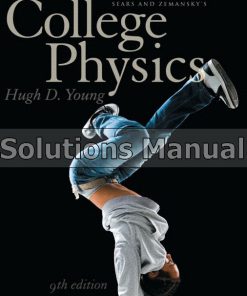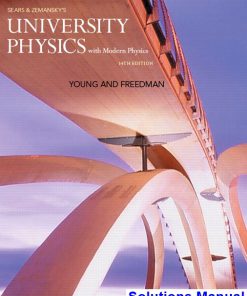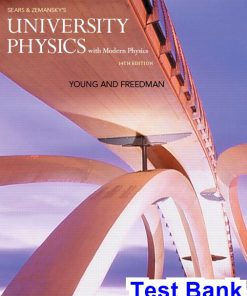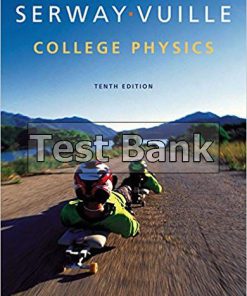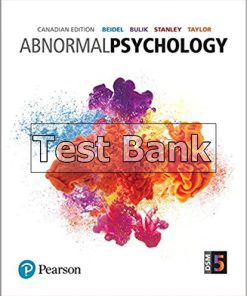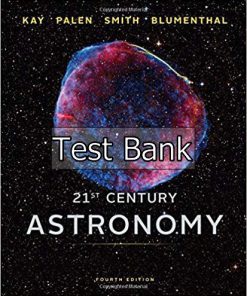College Physics 10th Edition Young Test Bank
You may also like
-
$26.50
$50.00
College Physics 10th Edition Young Test Bank
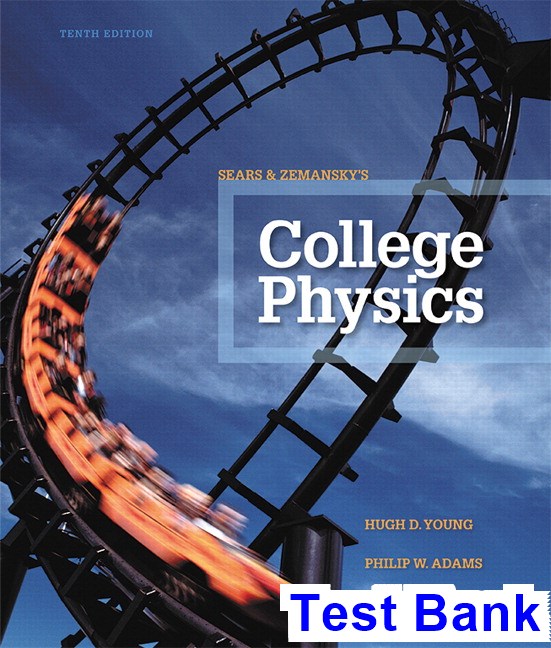
Product details:
- ISBN-10 : 0321902785
- ISBN-13 : 978-0321902788
- Author: Hugh D. Young
Bringing the best of physics education research to a trusted and classic text
For more than five decades, Sears and Zemansky’s College Physics has provided the most reliable foundation of physics education for students around the world. New coauthors Phil Adams and Ray Chastain thoroughly revised the Tenth Edition by incorporating the latest methods from educational research. New features help students develop greater confidence in solving problems, deepen conceptual understanding, and strengthen quantitative-reasoning skills, while helping them connect what they learn with their other courses and the changing world around them. New media resources in MasteringPhysics create an unrivalled learning suite for students and instructors
Table contents:
- Chapter 1: Introduction
- 1.1: Standards of Length, Mass, and Time
- 1.2: The Building Blocks of Matter
- 1.3: Dimensional Analysis (6)
- 1.4: Uncertainty Measurement and Significant Figures (8)
- 1.5: Conversion of Units (14)
- 1.6: Estimates and Order-of-Magnitude Calculations (7)
- 1.7: Coordinate Systems (7)
- 1.8: Trigonometry (11)
- 1.9: Problem-Solving Strategy
- 1: Additional Problems (15)
- 1: Warm-Up Exercises (9)
- 1: Conceptual Questions (13)
- 1: Active Examples (9)
- 1: Active Figures
- 1: Training Tutorials (1)
- 1: PreLecture Explorations
- Chapter 2: Motion in One Dimension
- 2.1: Displacement
- 2.2: Velocity (20)
- 2.3: Acceleration (6)
- 2.4: Motion Diagrams
- 2.5: One-Dimensional Motion with Constant Acceleration (21)
- 2.6: Freely Falling Objects (10)
- 2: Additional Problems (23)
- 2: Warm-Up Exercises (7)
- 2: Conceptual Questions (14)
- 2: Active Examples (9)
- 2: Active Figures
- 2: Training Tutorials (1)
- 2: Quick Quizzes (8)
- 2: PreLecture Explorations
- Chapter 3: Vectors and Two-Dimensional Motion
- 3.1: Vectors and Their Properties (9)
- 3.2: Components of a Vector (13)
- 3.3: Displacement, Velocity, and Acceleration in Two Dimensions
- 3.4: Motion in Two Dimensions (14)
- 3.5: Relative Velocity (10)
- 3: Additional Problems (33)
- 3: Warm-Up Exercises (9)
- 3: Conceptual Questions (15)
- 3: Active Examples (11)
- 3: Active Figures
- 3: Training Tutorials (2)
- 3: Quick Quizzes (5)
- 3: PreLecture Explorations
- Chapter 4: The Laws of Motion
- 4.1: Forces
- 4.2: Newton’s First Law
- 4.3: Newton’s Second Law
- 4.4: Newton’s Third Law (17)
- 4.5: Applications of Newton’s Laws (23)
- 4.6: Forces of Friction (18)
- 4: Additional Problems (33)
- 4: Warm-Up Exercises (13)
- 4: Conceptual Questions (21)
- 4: Active Examples (13)
- 4: Active Figures
- 4: Training Tutorials (5)
- 4: Quick Quizzes (7)
- 4: PreLecture Explorations
- Chapter 5: Energy
- 5.1: Work (10)
- 5.2: Kinetic Energy and the Work-Energy Theorem (10)
- 5.3: Gravitational Potential Energy
- 5.4: Spring Potential Energy (14)
- 5.5: Systems and Energy Conservation (19)
- 5.6: Power (9)
- 5.7: Work Done by a Varying Force (4)
- 5: Additional Problems (32)
- 5: Warm-Up Exercises (10)
- 5: Conceptual Questions (20)
- 5: Active Examples (16)
- 5: Active Figures
- 5: Training Tutorials (5)
- 5: Quick Quizzes (4)
- 5: PreLecture Explorations
- Chapter 6: Momentum and Collisions
- 6.1: Momentum and Impulse (21)
- 6.2: Conservation of Momentum (8)
- 6.3: Collisions
- 6.4: Glancing Collisions (25)
- 6.5: Rocket Propulsion
- 6: Additional Problems (30)
- 6: Warm-Up Exercises (11)
- 6: Conceptual Questions (18)
- 6: Active Examples (8)
- 6: Active Figures
- 6: Training Tutorials (2)
- 6: Quick Quizzes (6)
- 6: PreLecture Explorations
- Chapter 7: Rotational Motion and the Law of Gravity
- 7.1: Angular Speed and Angular Acceleration (4)
- 7.2: Rotational Motion Under Constant Angular Acceleration
- 7.3: Relations Between Angular and Linear Quantities (11)
- 7.4: Centripetal Acceleration (20)
- 7.5: Newtonian Gravitation (8)
- 7.6: Kepler’s Laws (6)
- 7: Additional Problems (32)
- 7: Warm-Up Exercises (15)
- 7: Conceptual Questions (13)
- 7: Active Examples (13)
- 7: Active Figures
- 7: Training Tutorials (2)
- 7: Quick Quizzes (10)
- 7: PreLecture Explorations
- Chapter 8: Rotational Equilibrium and Rotational Dynamics
- 8.1: Torque (7)
- 8.2: Torque and the Two Conditions for Equilibrium
- 8.3: The Center of Gravity
- 8.4: Examples of Objects in Equilibrium (25)
- 8.5: Relationship Between Torque and Angular Acceleration (12)
- 8.6: Rotational Kinetic Energy (12)
- 8.7: Angular Momentum (15)
- 8: Additional Problems (23)
- 8: Warm-Up Exercises (14)
- 8: Conceptual Questions (17)
- 8: Active Examples (15)
- 8: Active Figures
- 8: Training Tutorials (4)
- 8: Quick Quizzes (6)
- 8: PreLecture Explorations
- Chapter 9: Solids and Fluids
- 9.1: States of Matter
- 9.2: Density and Pressure (8)
- 9.3: The Deformation of Solids (14)
- 9.4: Variation of Pressure with Depth
- 9.5: Pressure Measurements (9)
- 9.6: Buoyant Forces and Archimedes’ Principle (16)
- 9.7: Fluids in Motion
- 9.8: Other Applications of Fluid Dynamics (16)
- 9.9: Surface Tension, Capillary Action, and Viscous Fluid Flow (14)
- 9.10: Transport Phenomena (4)
- 9: Additional Problems (15)
- 9: Warm-Up Exercises (11)
- 9: Conceptual Questions (15)
- 9: Active Examples (16)
- 9: Active Figures
- 9: Training Tutorials (2)
- 9: Quick Quizzes (6)
- 9: PreLecture Explorations
- Chapter 10: Thermal Physics
- 10.1: Temperature and the Zeroth Law of Thermodynamics
- 10.2: Thermometers and Temperature Scales (11)
- 10.3: Thermal Expansion of Solids and Liquids (19)
- 10.4: Macroscopic Description of an Ideal Gas (11)
- 10.5: The Kinetic Theory of Gases (9)
- 10: Additional Problems (19)
- 10: Warm-Up Exercises (10)
- 10: Conceptual Questions (14)
- 10: Active Examples (9)
- 10: Active Figures
- 10: Training Tutorials (1)
- 10: Quick Quizzes (4)
- 10: PreLecture Explorations
- Chapter 11: Energy in Thermal Processes
- 11.1: Heat and Internal Energy
- 11.2: Specific Heat (15)
- 11.3: Calorimetry (12)
- 11.4: Latent Heat and Phase Change (14)
- 11.5: Energy Transfer (14)
- 11.6: Global Warming and Greenhouse Gases
- 11: Additional Problems (24)
- 11: Warm-Up Exercises (9)
- 11: Conceptual Questions (15)
- 11: Active Examples (7)
- 11: Training Tutorials (1)
- 11: Quick Quizzes (5)
- 11: PreLecture Explorations
- Chapter 12: The Laws of Thermodynamics
- 12.1: Work in Thermodynamic Processes (11)
- 12.2: The First Law of Thermodynamics
- 12.3: Thermal Processes (19)
- 12.4: Heat Engines and the Second Law of Thermodynamics (17)
- 12.5: Entropy (11)
- 12.6: Human Metabolism (3)
- 12: Additional Problems (16)
- 12: Warm-Up Exercises (14)
- 12: Conceptual Questions (17)
- 12: Active Examples (16)
- 12: Active Figures
- 12: Training Tutorials (2)
- 12: Quick Quizzes (5)
- 12: PreLecture Explorations
- Chapter 13: Vibrations and Waves
- 13.1: Hooke’s Law (7)
- 13.2: Elastic Potential Energy (9)
- 13.3: Comparing Simple Harmonic Motion with Uniform Circular Motion
- 13.4: Position, Velocity, and Acceleration as a Function of Time (19)
- 13.5: Motion of a Pendulum (8)
- 13.6: Damped Oscillations
- 13.7: Waves
- 13.8: Frequency, Amplitude, and Wavelength (8)
- 13.9: The Speed of Waves on Strings (14)
- 13.10: Interference of Waves
- 13.11: Reflection of Waves (1)
- 13: Additional Problems (16)
- 13: Warm-Up Exercises (11)
- 13: Conceptual Questions (12)
- 13: Active Examples (9)
- 13: Active Figures
- 13: Training Tutorials (1)
- 13: Quick Quizzes (9)
- 13: PreLecture Explorations
- Chapter 14: Sound
- 14.1: Producing a Sound Wave
- 14.2: Characteristics of Sound Waves
- 14.3: The Speed of Sound (9)
- 14.4: Energy and Intensity of Sound Waves
- 14.5: Spherical and Plane Waves (14)
- 14.6: The Doppler Effect (12)
- 14.7: Interference of Sound Waves (5)
- 14.8: Standing Waves (11)
- 14.9: Forced Vibrations and Resonance (1)
- 14.10: Standing Waves in Air Columns (7)
- 14.11: Beats (5)
- 14.12: Quality of Sound
- 14.13: The Ear (2)
- 14: Additional Problems (16)
- 14: Warm-Up Exercises (14)
- 14: Conceptual Questions (11)
- 14: Active Examples (10)
- 14: Active Figures
- 14: Training Tutorials (2)
- 14: Quick Quizzes (7)
- 14: PreLecture Explorations
- Chapter 15: Electric Forces and Electric Fields
- 15.1: Properties of Electric Charges
- 15.2: Insulators and Conductors
- 15.3: Coulomb’s Law (16)
- 15.4: The Electric Field (14)
- 15.5: Electric Field Lines
- 15.6: Conductors in Electrostatic Equilibrium (6)
- 15.7: The Millikan Oil-Drop Experiment
- 15.8: The Van de Graaff Generator (4)
- 15.9: Electric Flux and Gauss’s Law (10)
- 15: Additional Problems (18)
- 15: Warm-Up Exercises (14)
- 15: Conceptual Questions (17)
- 15: Active Examples (6)
- 15: Active Figures
- 15: Training Tutorials (2)
- 15: Quick Quizzes (10)
- 15: PreLecture Explorations
- Chapter 16: Electrical Energy and Capacitance
- 16.1: Electric Potential Energy and Electric Potential (11)
- 16.2: Electric Potential and Potential Energy Due to Point Charges
- 16.3: Potentials and Charged Conductors
- 16.4: Equipotential Surfaces (15)
- 16.5: Applications
- 16.6: Capacitance
- 16.7: The Parallel-Plate Capacitor (9)
- 16.8: Combinations of Capacitors (13)
- 16.9: Energy Stored in a Charged Capacitor (4)
- 16.10: Capacitors with Dielectrics (5)
- 16: Additional Problems (16)
- 16: Warm-Up Exercises (12)
- 16: Conceptual Questions (13)
- 16: Active Examples (9)
- 16: Active Figures
- 16: Training Tutorials (2)
- 16: Quick Quizzes (11)
- 16: PreLecture Explorations
- Chapter 17: Current and Resistance
- 17.1: Electric Current
- 17.2: A Microscopic View: Current and Drift Speed (10)
- 17.3: Current and Voltage Measurements In Circuits
- 17.4: Resistance, Resistivity, and Ohm’s Law (13)
- 17.5: Temperature Variation of Resistance (12)
- 17.6: Electrical Energy and Power (17)
- 17.7: Superconductors
- 17.8: Electrical Activity in the Heart
- 17: Additional Problems (19)
- 17: Warm-Up Exercises (10)
- 17: Conceptual Questions (11)
- 17: Active Examples (6)
- 17: Active Figures
- 17: Training Tutorials (1)
- 17: Quick Quizzes (10)
- 17: PreLecture Explorations
- Chapter 18: Direct-Current Circuits
- 18.1: Sources of emf
- 18.2: Resistors in Series
- 18.3: Resistors in Parallel (16)
- 18.4: Kirchhoff’s Rules and Complex DC Circuits (16)
- 18.5: RC Circuits (7)
- 18.6: Household Circuits (5)
- 18.7: Electrical Safety
- 18.8: Conduction of Electrical Signals by Neurons (3)
- 18: Additional Problems (24)
- 18: Warm-Up Exercises (13)
- 18: Conceptual Questions (14)
- 18: Active Examples (7)
- 18: Active Figures
- 18: Training Tutorials (2)
- 18: Quick Quizzes (9)
- 18: PreLecture Explorations
- Chapter 19: Magnetism
- 19.1: Magnets
- 19.2: Earth’s Magnetic Field
- 19.3: Magnetic Fields (13)
- 19.4: Magnetic Force on a Current-Carrying Conductor (13)
- 19.5: Torque on a Current Loop and Electric Motors (9)
- 19.6: Motion of a Charged Particle in a Magnetic Field (10)
- 19.7: Magnetic Field of a Long, Straight Wire and Ampère’s Law (13)
- 19.8: Magnetic Force Between Two Parallel Conductors (4)
- 19.9: Magnetic Fields of Current Loops and Solenoids (6)
- 19.10: Magnetic Domains
- 19: Additional Problems (13)
- 19: Warm-Up Exercises (9)
- 19: Conceptual Questions (19)
- 19: Active Examples (8)
- 19: Active Figures
- 19: Training Tutorials (2)
- 19: Quick Quizzes (6)
- 19: PreLecture Explorations
- Chapter 20: Induced Voltages and Inductance
- 20.1: Induced emf and Magnetic Flux (8)
- 20.2: Faraday’s Law of Induction and Lenz’s Law (16)
- 20.3: Motional emf (9)
- 20.4: Generators (7)
- 20.5: Self-Inductance (6)
- 20.6: RL Circuits (6)
- 20.7: Energy Stored in a Magnetic Field (5)
- 20: Additional Problems (15)
- 20: Warm-Up Exercises (10)
- 20: Conceptual Questions (14)
- 20: Active Examples (9)
- 20: Active Figures
- 20: Training Tutorials (3)
- 20: Quick Quizzes (6)
- 20: PreLecture Explorations
- Chapter 21: Alternating-Current Circuits and Electromagnetic Waves
- 21.1: Resistors in an AC Circuit (6)
- 21.2: Capacitors in an AC Circuit (7)
- 21.3: Inductors in an AC Circuit (6)
- 21.4: The RLC Series Circuit (13)
- 21.5: Power in an AC Circuit (7)
- 21.6: Resonance in a Series RLC Circuit (7)
- 21.7: The Transformer (6)
- 21.8: Maxwell’s Predictions
- 21.9: Hertz’s Confirmation of Maxwell’s Predictions
- 21.10: Production of Electromagnetic Waves by an Antenna
- 21.11: Properties of Electromagnetic Waves (10)
- 21.12: The Spectrum of Electromagnetic Waves (5)
- 21.13: The Doppler Effect for Electromagnetic Waves (3)
- 21: Additional Problems (11)
- 21: Warm-Up Exercises (11)
- 21: Conceptual Questions (19)
- 21: Active Examples (9)
- 21: Active Figures
- 21: Training Tutorials (2)
- 21: Quick Quizzes (8)
- 21: PreLecture Explorations
- Chapter 22: Reflection and Refraction of Light
- 22.1: The Nature of Light (8)
- 22.2: Reflection and Refraction
- 22.3: The Law of Refraction (22)
- 22.4: Dispersion and Prisms (7)
- 22.5: The Rainbow
- 22.6: Huygens’ Principle
- 22.7: Total Internal Reflection (12)
- 22: Additional Problems (17)
- 22: Warm-Up Exercises (5)
- 22: Conceptual Questions (15)
- 22: Active Examples (5)
- 22: Active Figures
- 22: Training Tutorials (1)
- 22: Quick Quizzes (4)
- 22: PreLecture Explorations
- Chapter 23: Mirrors and Lenses
- 23.1: Flat Mirrors (5)
- 23.2: Images Formed by Concave Mirrors
- 23.3: Convex Mirrors and Sign Conventions (17)
- 23.4: Images Formed by Refraction (8)
- 23.5: Atmospheric Refraction
- 23.6: Thin Lenses (20)
- 23.7: Lens and Mirror Aberrations
- 23: Additional Problems (21)
- 23: Warm-Up Exercises (7)
- 23: Conceptual Questions (17)
- 23: Active Examples (9)
- 23: Active Figures
- 23: Training Tutorials (2)
- 23: Quick Quizzes (5)
- 23: PreLecture Explorations
- Chapter 24: Wave Optics
- 24.1: Conditions for Interference
- 24.2: Young’s Double-Slit Experiment (17)
- 24.3: Change of Phase Due to Reflection
- 24.4: Interference in Thin Films (16)
- 24.5: Using Interference to Read CDs and DVDs
- 24.6: Diffraction
- 24.7: Single-Slit Diffraction (9)
- 24.8: The Diffraction Grating (13)
- 24.9: Polarization of Light Waves (12)
- 24: Additional Problems (13)
- 24: Warm-Up Exercises (10)
- 24: Conceptual Questions (16)
- 24: Active Examples (8)
- 24: Active Figures
- 24: Training Tutorials (3)
- 24: Quick Quizzes (6)
- 24: PreLecture Explorations
- Chapter 25: Optical Instruments
- 25.1: The Camera (8)
- 25.2: The Eye (11)
- 25.3: The Simple Magnifier (6)
- 25.4: The Compound Microscope
- 25.5: The Telescope (13)
- 25.6: Resolution of Single-Slit and Circular Apertures (11)
- 25.7: The Michelson Interferometer (7)
- 25: Additional Problems (11)
- 25: Warm-Up Exercises (12)
- 25: Conceptual Questions (15)
- 25: Active Examples (8)
- 25: Active Figures
- 25: Training Tutorials (2)
- 25: PreLecture Explorations
- Chapter 26: Relativity
- 26.1: Galilean Relativity
- 26.2: The Speed of Light
- 26.3: Einstein’s Principle of Relativity
- 26.4: Consequences of Special Relativity (13)
- 26.5: Relativistic Momentum (3)
- 26.6: Relative Velocity in Special Relativity (7)
- 26.7: Relativistic Energy and the Equivalence of Mass and Energy (9)
- 26.8: General Relativity
- 26: Additional Problems (23)
- 26: Warm-Up Exercises (10)
- 26: Conceptual Questions (12)
- 26: Active Examples (5)
- 26: Active Figures
- 26: Training Tutorials (1)
- 26: Quick Quizzes (7)
- 26: PreLecture Explorations
- Chapter 27: Quantum Physics
- 27.1: Blackbody Radiation and Planck’s Hypothesis (9)
- 27.2: The Photoelectric Effect and the Particle Theory of Light (6)
- 27.3: X-Rays (3)
- 27.4: Diffraction of X-Rays by Crystals (5)
- 27.5: The Compton Effect (6)
- 27.6: The Dual Nature of Light and Matter (6)
- 27.7: The Wave Function
- 27.8: The Uncertainty Principle (7)
- 27: Additional Problems (13)
- 27: Warm-Up Exercises (11)
- 27: Conceptual Questions (16)
- 27: Active Examples (5)
- 27: Active Figures
- 27: Training Tutorials (1)
- 27: Quick Quizzes (5)
- 27: PreLecture Explorations
- Chapter 28: Atomic Physics
- 28.1: Early Models of the Atom
- 28.2: Atomic Spectra (5)
- 28.3: The Bohr Model (23)
- 28.4: Quantum Mechanics and the Hydrogen Atom (3)
- 28.5: The Exclusion Principle and the Periodic Table (4)
- 28.6: Characteristic X-Rays (5)
- 28.7: Atomic Transitions and Lasers
- 28: Additional Problems (10)
- 28: Warm-Up Exercises (10)
- 28: Conceptual Questions (15)
- 28: Active Examples (4)
- 28: Active Figures
- 28: Training Tutorials (1)
- 28: Quick Quizzes (3)
- 28: PreLecture Explorations
- Chapter 29: Nuclear Physics
- 29.1: Some Properties of Nuclei (9)
- 29.2: Binding Energy (6)
- 29.3: Radioactivity (9)
- 29.4: The Decay Processes (10)
- 29.5: Natural Radioactivity
- 29.6: Nuclear Reactions (8)
- 29.7: Medical Applications of Radiation (8)
- 29: Additional Problems (11)
- 29: Warm-Up Exercises (10)
- 29: Conceptual Questions (13)
- 29: Active Examples (2)
- 29: Active Figures
- 29: Training Tutorials (1)
- 29: Quick Quizzes (5)
- 29: PreLecture Explorations
- Chapter 30: Nuclear Energy and Elementary Particles
- 30.1: Nuclear Fission (13)
- 30.2: Nuclear Fusion (6)
- 30.3: Elementary Particles and the Fundamental Forces
- 30.4: Positrons and Other Antiparticles (4)
- 30.5: Classification of Particles
- 30.6: Conservation Laws (6)
- 30.7: The Eightfold Way
- 30.8: Quarks and Color (6)
- 30.9: Electroweak Theory and the Standard Model
- 30.10: The Cosmic Connection
- 30.11: Unanswered Questions in Cosmology
- 30.12: Problems and Perspectives
- 30: Additional Problems (14)
- 30: Warm-Up Exercises (10)
- 30: Conceptual Questions (12)
- 30: Active Examples (4)
- 30: Active Figures
- 30: Training Tutorials (1)
- 30: Quick Quizzes (2)
- 30: PreLecture Explorations
People also search:
college physics 10th edition pdf free download
college physics 10th edition
college physics 10th edition serway
college physics 10th edition answers
sears and zemansky’s college physics 10th edition


